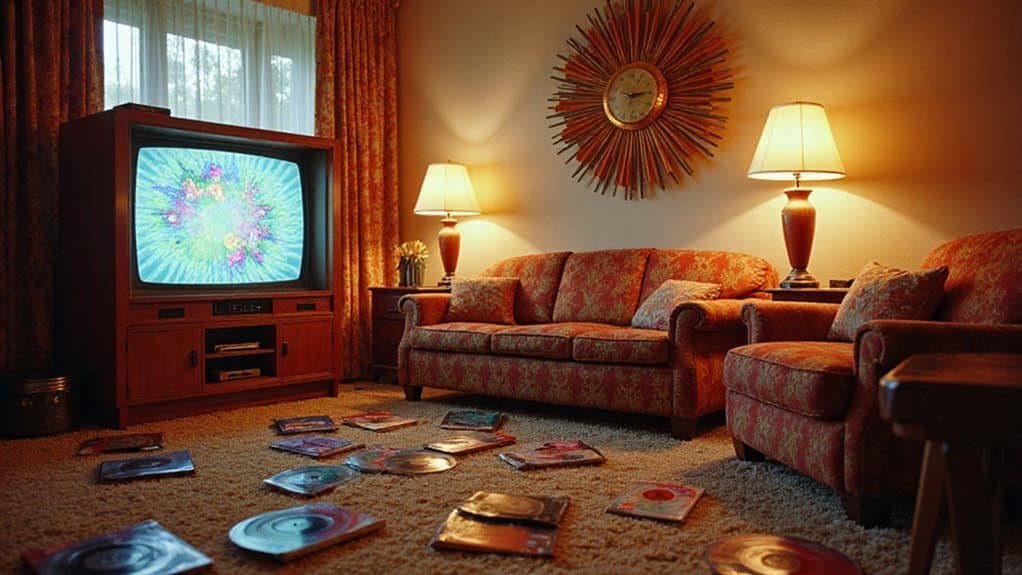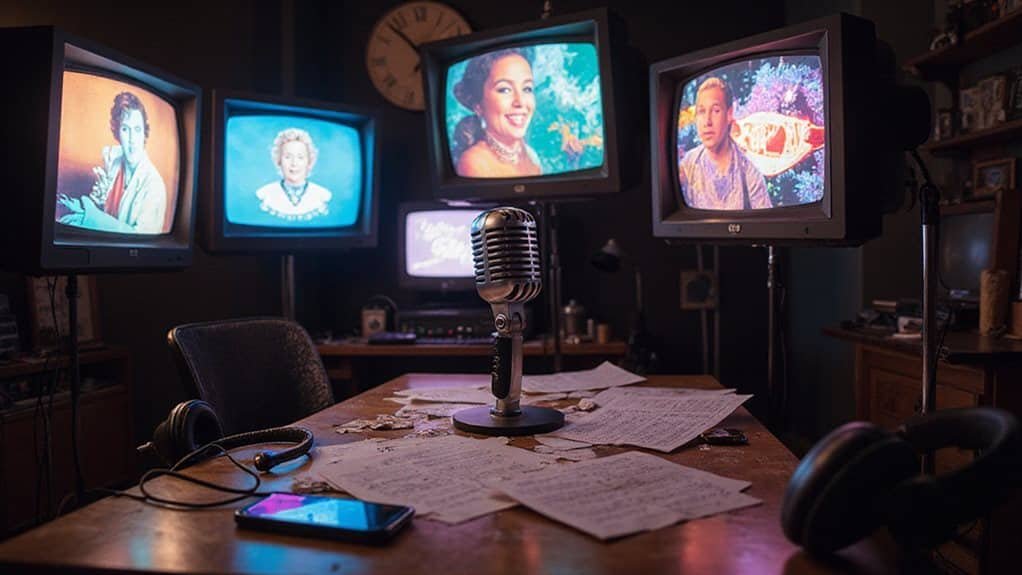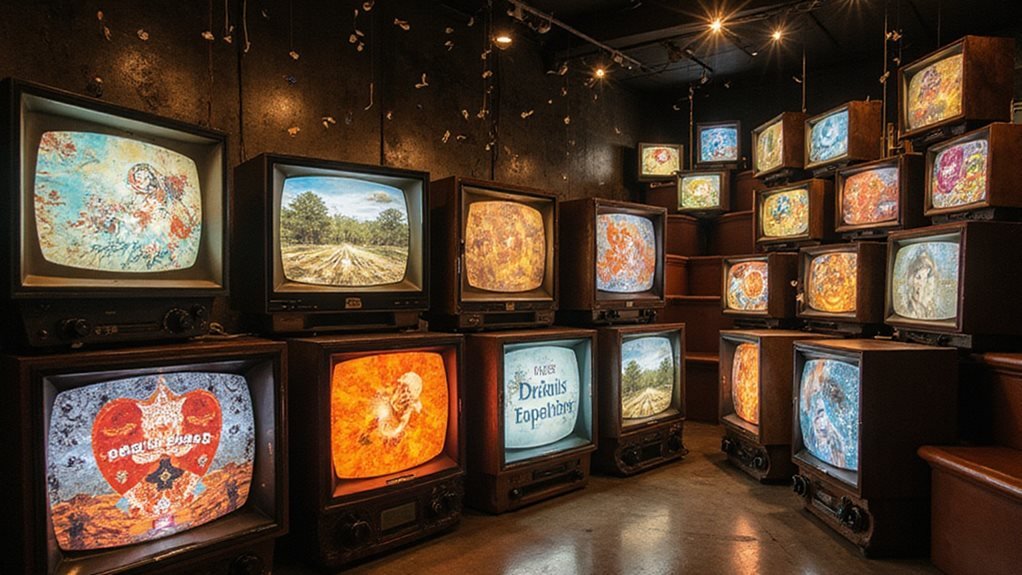The evolution of TV jingles is an intriguing reflection of changing media, audience perceptions, and technological innovations. From their origins in radio to becoming integral components of television advertising, jingles have continuously adapted to cultural and technological shifts. Their development involves catchy melodies, creative collaborations, and significant influence on consumer behavior. In today’s digital age, they maintain nostalgic value while adapting to new platforms. This expedition reveals much about society’s relationship with media and advertising.
Transforming Sounds of TV Jingles, Cary Reich, The Jingle WriterKey Takeaways
- TV jingles originated from radio ads, embedding products into public consciousness with catchy melodies in the early 20th century.
- The 1970s saw a creative shift, integrating various musical genres and incorporating professional musicians for deeper audience engagement.
- Jingles transitioned to a multisensory experience on TV, combining visual elements for enhanced retention and relatability.
- Globalization introduced cross-genre fusion, allowing jingles to appeal to broader and diverse demographics globally.
- Social media has amplified jingle reach through viral campaigns, fostering nostalgia and cultural continuity across generations.
The Birth of Jingles on Radio
While the history of jingles is often associated with television, their genesis can be traced back to the early days of radio broadcasting. Initially, radio served as a novel medium capable of engaging a vast audience, thereby offering a fertile ground for the nascent stage of the TV jingle evolution. In this context, advertisers recognized the potential of short, musical advertisements—jingles—as a tool to etch products into the public’s consciousness. These catchy audio snippets evolved as they adapted the cultural zeitgeist, embedding themselves into the rhythmic fabric of social everyday life. Consequently, radio pioneered the structuring principles of jingles, establishing an auditory palette from which television would eventually draw, refining the art to suit evolving consumer dynamics and fostering a sense of collective nostalgia.
Transitioning to Television Screens

The shift of jingles to television screens marked a significant change in advertising strategies, integrating visual elements with auditory branding to improve consumer engagement. This period witnessed jingles evolving beyond their auditory roots to incorporate vibrant imagery, which facilitated a more immersive and multisensory experience. By combining music with visuals, advertisers were able to capture audience attention more effectively, creating a deeper sentimental connection with their target market.
Jingles’ Visual Transformation
How did jingles adapt during the change from radio to television screens? This pivotal phase demanded a visually compelling narrative that harmonized with the auditory element. Brands rapidly recognized the necessity of supplementing the audio with engaging visuals to captivate an audience now accustomed to the allure of moving images. The integration of graphics, animation, and live-action sequences transformed jingles into thorough visual stories that reinforced brand identity. The visuals often mirrored cultural trends, thereby enhancing the relevance and memorability of the message. This shift capitalized on television’s dual ability to visually reinforce a jingle’s message while maintaining its melodic catchiness. As a result, jingles became more versatile, reaching audiences intellectually and affectively across society’s diverse fabric, seeking shared cultural touchpoints.
Engaging Multisensory Experience
Building upon jingles’ visual transformation with the advent of television, an extensive multisensory experience emerged as a significant advancement in advertising. This evolution tapped into the power of sight and sound to craft memorable brand identities, engendering a sense of community among audiences. Analyzing this shift reveals several key components that enriched viewer engagement:
- Visual Symbolism: Graphics and animations provided context, complementing the jingle’s auditory appeal.
- Cognitive Resonance: Catchy tunes coupled with visuals aided in mnemonic retention, embedding brands within cultural memory.
- Affective Connection: Sentimental responses were solicited through evocative imagery synchronized with melodies.
- Narrative Efficiency: Brief storytelling within ads fostered immediate understanding and relatability.
- Cultural Synchrony: Jingles mirrored societal trends, reinforcing a collective cultural experience.
This multisensory synthesis reinforced viewers’ sense of belonging and advertiser connectivity.
Iconic Jingles of the 1950s and 1960s

In the era of the 1950s and 1960s, television jingles became an instrumental tool for advertisers, characterized by memorable, catchy melodies that left enduring impressions on the audience. These jingles employed effective advertising strategies by integrating concise, repetitive tunes with easily recognizable brand messages, thereby enhancing product recall during and beyond commercial breaks. The cultural impact of these jingles was profound, as they not only reflected but also shaped consumer behaviors and societal trends of the time, embedding themselves into the collective cultural memory.
Memorable Catchy Melodies
The evolution of television jingles during the 1950s and 1960s marked a significant change in advertising strategies, characterized by the emergence of catchy melodies that became deeply ingrained in popular culture. These jingles, short musical compositions, effectively paired brand identities with memorable tunes that resonated with audiences, fostering a sense of communal familiarity. The distinctive characteristics of iconic jingles from this era include:
- Repetition of simple hooks: Guaranteed recall and built brand association.
- Use of upbeat rhythms: Evoked positive emotions, engaging listeners.
- Integration into daily life: Became part of everyday conversations.
- Cultural reflection: Mirrored the societal mood and zeitgeist of the time.
- Adaptability across media: Supported shifts from radio to television, enhancing their reach.
This strategic utilization of music not only captured attention but also transcended generational lines, embedding these melodies in the collective memory.
Effective Advertising Strategies
Following the discussion on memorable catchy melodies, the focus now shifts to examining the effective advertising strategies that iconic jingles from the 1950s and 1960s employed. During this era, advertisers adeptly combined repetition, simplicity, and sentimental connection to captivate audiences. By leveraging repetitive, simple tunes, jingles guaranteed that product names lingered in consumers’ minds. This repetition fortified brand recognition and recall, crucial for audience retention in a rapidly growing market. Strategically, these jingles thrived on cultural relevance, weaving societal themes and values into their narratives, which resonated with the post-war generation. By emphasizing familial and aspirational paradigms, these tunes forged strong sentimental bonds with consumers, fostering loyalty and a sense of shared cultural identity in an era of burgeoning mass media consumption.
Cultural Impact Moments
Though often overlooked in contemporary discourse, the jingles of the 1950s and 1960s hold a profound cultural significance, serving as auditory milestones that encapsulate the ethos of their era. During this period, television became a centerpiece in American homes, and jingles emerged as powerful agents of cultural influence. Brands cleverly utilized these catchy tunes to embed themselves in the collective consciousness, forging a sense of shared identity among consumers.
Consider the following iconic moments:
- Colgate’s “Brush Your Teeth with Colgate”: Instilled daily hygiene habits.
- Oscar Mayer’s “My Bologna Has a Primary Name”: Made lunchtime fun for children.
- Coca-Cola’s “Things Go Better with Coke”: Defined social interactions.
- Mr. Clean’s “Gets Tough Dirt”: Reinforced domestic cleanliness.
- Winston’s “Tastes Good Like a Cigarette Should”: Captured tobacco’s appeal.
The Creative Explosion of the 1970s

Invariably, the 1970s marked a pivotal era for the evolution of TV jingles, characterized by a remarkable creative explosion that reshaped advertising strategies. This decade saw a surge in uniqueness, driven by cultural shifts and technological advancements. Advertisers, recognizing television’s expanding influence, welcomed cutting-edge jingles to bolster brand identity and consumer loyalty. The era witnessed the integration of diverse musical genres into jingles, reflecting the societal changes and multicultural dynamics of the time. Collaborations between advertisers and professional musicians became prevalent, resulting in more sophisticated and memorable jingles. This trend not only captivated audiences but also fostered a sense of community among viewers, who connected over shared experiences of these catchy musical narratives, thereby creating a unified consumer culture.
Modernizing Melodies in the 1980s and 1990s

The creative surge of the 1970s laid a dynamic foundation for the subsequent decades, preparing the ground for the modernization of TV jingles throughout the 1980s and 1990s. This period showcased a shift towards sophistication and integration of popular culture elements within jingles. Brands focused on crafting memorable and marketable tunes that resonated with diverse audiences.
- Complex Harmonies: Jingles incorporated richer musical arrangements, enhancing the heartfelt connection.
- Crossover Appeal: Artists from mainstream music ventured into jingle composition, bringing crossover appeal.
- Narrative Techniques: Storytelling became central, creating a cohesive brand narrative within a short timeframe.
- Diverse Genres: Incorporation of rock, pop, and R&B helped reach a broader demographic.
- Cultural Reflection: Melodies mirrored societal changes, adding relevance and relatability.
This era marked an evolution where jingles transcended mere advertising to become cultural touchstones.
Technological Advancements and Digital Influence

As the new millennium approached, rapid technological advancements began to influence the world of TV jingles greatly, reshaping how they were created, distributed, and consumed. Digital audio workstations allowed composers exceptional precision and creativity, enabling complex arrangements and high-quality sound production. The internet facilitated global distribution, making jingles more accessible to broader audiences and enhancing collaboration among composers across different regions. Social media platforms provided diverse avenues for audience engagement, allowing jingles to transcend traditional broadcast boundaries and fostering a sense of community among viewers. As algorithms evolved, data-driven insights increasingly informed jingle composition, tailoring them to resonate with target demographics. This digital transformation enabled creators while integrating jingle culture seamlessly into the fabric of everyday media consumption.
Cross-Genre Fusion and Globalization

With an ever-expanding musical landscape, cross-genre fusion and globalization have significantly transformed TV jingles, integrating distinct musical elements from across the globe. This phenomenon allows brands to connect with multicultural audiences by transcending traditional genre boundaries. Fusion enables the creation of novel auditory experiences that influence audience perception and brand recognition. By embracing musical variety, jingles become a symbol of cultural exchange, fostering a sense of global belonging.
- Cultural diversity: Jingles incorporate musical styles from different cultures.
- Innovative soundscapes: Blend of different genres for singular audio identity.
- Cross-border collaborations: Musicians from different countries collaborate.
- Broader audience reach: Appeals to global and multicultural audiences.
- Dynamic adaptability: Improved flexibility of jingles to fit varied contexts.
This evolution underscores the role of music as a universal language in brand communication.
Jingles in the Age of Social Media

Building upon the cultural exchange facilitated by cross-genre fusion and globalization, jingles have now permeated the online environment, specifically through the robust and pervasive platform of social media. This medium amplifies their reach and adaptability, aligning with contemporary digital consumption trends. Social media facilitates user-driven content creation, whereby jingles are remixed, parodied, or repurposed, enhancing their cultural resonance. Viral marketing campaigns utilize these catchy audio segments to foster heartfelt connections and community engagement, aligning with audience values and culture. The integration of jingles into memes or challenges on platforms such as TikTok and Instagram demonstrates their malleability and enduring appeal. As users share and reinterpret jingles, these succinct, memorable melodies become integral to online communal narratives.
The Enduring Legacy of TV Jingles

The enduring legacy of TV jingles lies in their unique ability to embed themselves in cultural memory, evoking nostalgia and sentiment across generations. These melodic fragments, often succinct and repetitive, have transcended their commercial intent to become cultural touchstones. Jingles create a sense of shared history and belonging through their powerful recall and heartfelt resonance. They exemplify the intersection of music and marketing in mass media.
- Cultural Memory: Jingles are remembered long after their initial airings, becoming part of the collective consciousness.
- Sentimental Resonance: Their catchy tunes and rhymes evoke fond memories and feelings linked to specific products or eras.
- Intergenerational Appeal: They bridge generational gaps, sparking conversations and shared experiences.
- Legacy in Advertising: Pioneered techniques are still used in advertising today.
- Influence on Pop Culture: Jingles often inspire parodies, adaptations, and remakes, embedding themselves in diverse cultural expressions.
Frequently Asked Questions
What Role Do Jingles Play in Today’s Streaming-Dominated Entertainment Landscape?
Jingles, once the siren songs of television, now navigate the complex seas of streaming. They maintain brand identity and communal nostalgia, serving as auditory anchors amidst the shifting sands of content consumption and short-form advertising strategies.
How Did Cultural Shifts Influence Jingle Production Over the Decades?
Cultural shifts, including technological advancements, societal values, and economic changes, significantly transformed jingle production. These shifts compelled marketers to adapt their strategies, emphasizing inclusivity, genuineness, and relevance, resonating with diverse audiences seeking connection and representation in media content.
Are There Psychological Impacts of Jingles on Consumer Behavior?
Studies indicate jingles increase brand recall by 34%, enhancing consumer engagement and fostering sentimental connections. This psychological impact utilizes auditory memory, influencing purchasing decisions and creating a collective cultural memory within a consumer community.
How Are Jingles Regulated in Terms of Copyright and Intellectual Property?
Jingles fall under copyright law, granting creators sole rights to their musical compositions. These rights encompass reproduction, distribution, and public performance, ensuring control and financial gain over their use in advertising, thereby fostering innovation and cultural continuity.
What Have Been Some Unsuccessful Jingles and Their Impact on Brands?
Unsuccessful jingles, like McDonald’s “We Do It All for You,” struggle due to a lack of resonance or memorability, potentially diminishing brand recognition and sentimental connection, ultimately affecting consumer loyalty and the company’s market position in a competitive landscape.
Conclusion
To sum up, the evolution of TV jingles demonstrates an intricate relationship with cultural and technological advances. This expedition is exemplified by the enduring “I’d Like to Buy the World a Coke” campaign, which transcended commercial utility to become a cultural anthem, resonating with global audiences. This example underscores jingles’ capacity to evoke deep, heartfelt connections and sustain relevance across eras, illustrating their power to adapt and thrive amid rapid media transformations in the digital age.

Cary Reich is a master jingle-writer with over 35 years of experience creating brand‐defining melodic slogans and audio identities. Since 1985, Cary has crafted memorable campaigns for both national and local clients — including Budweiser, Firestone, Gold’s Gym, Goodwill, and YMCA — blending creative vision and musical expertise to make businesses not just heard, but remembered.

